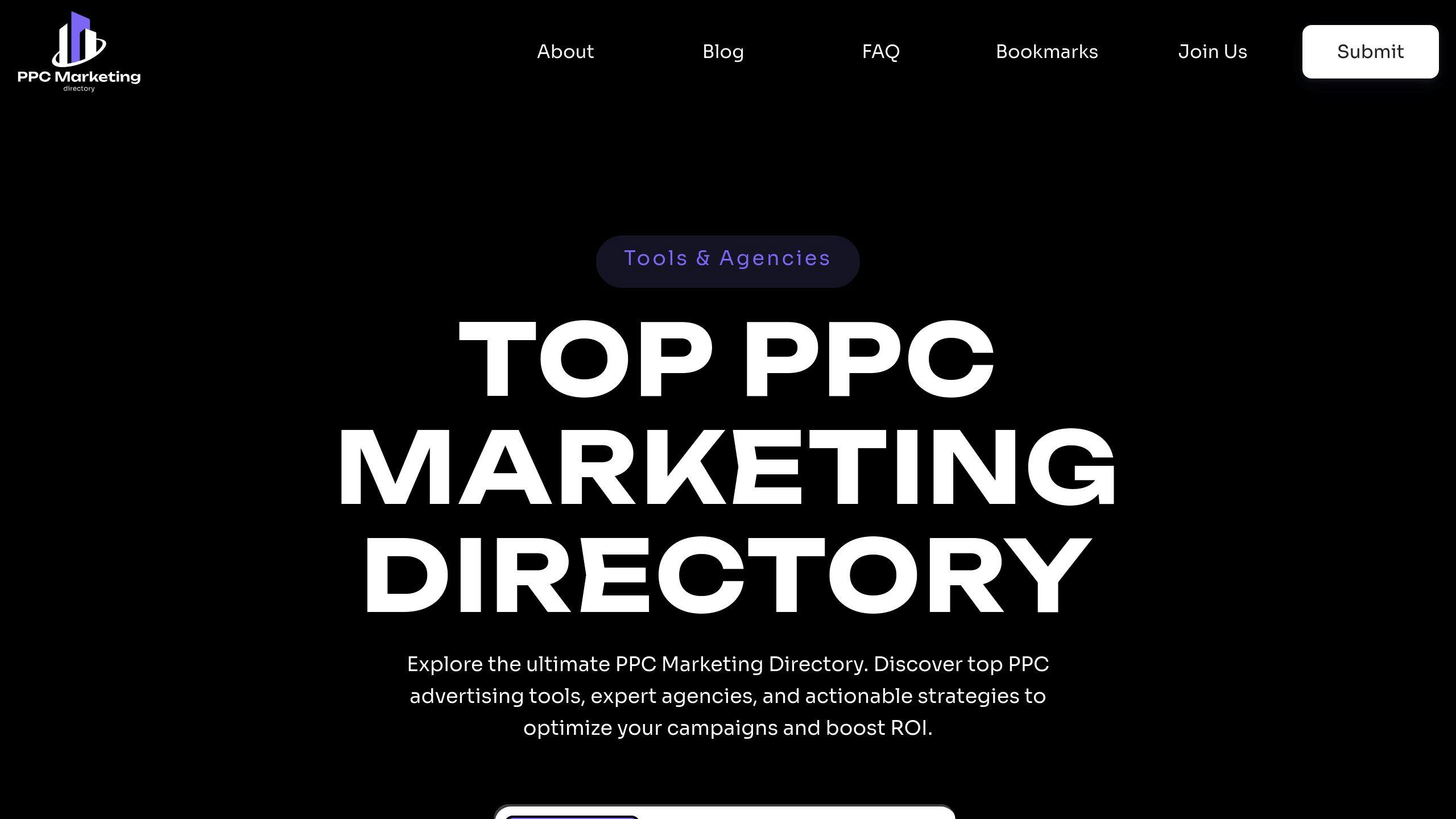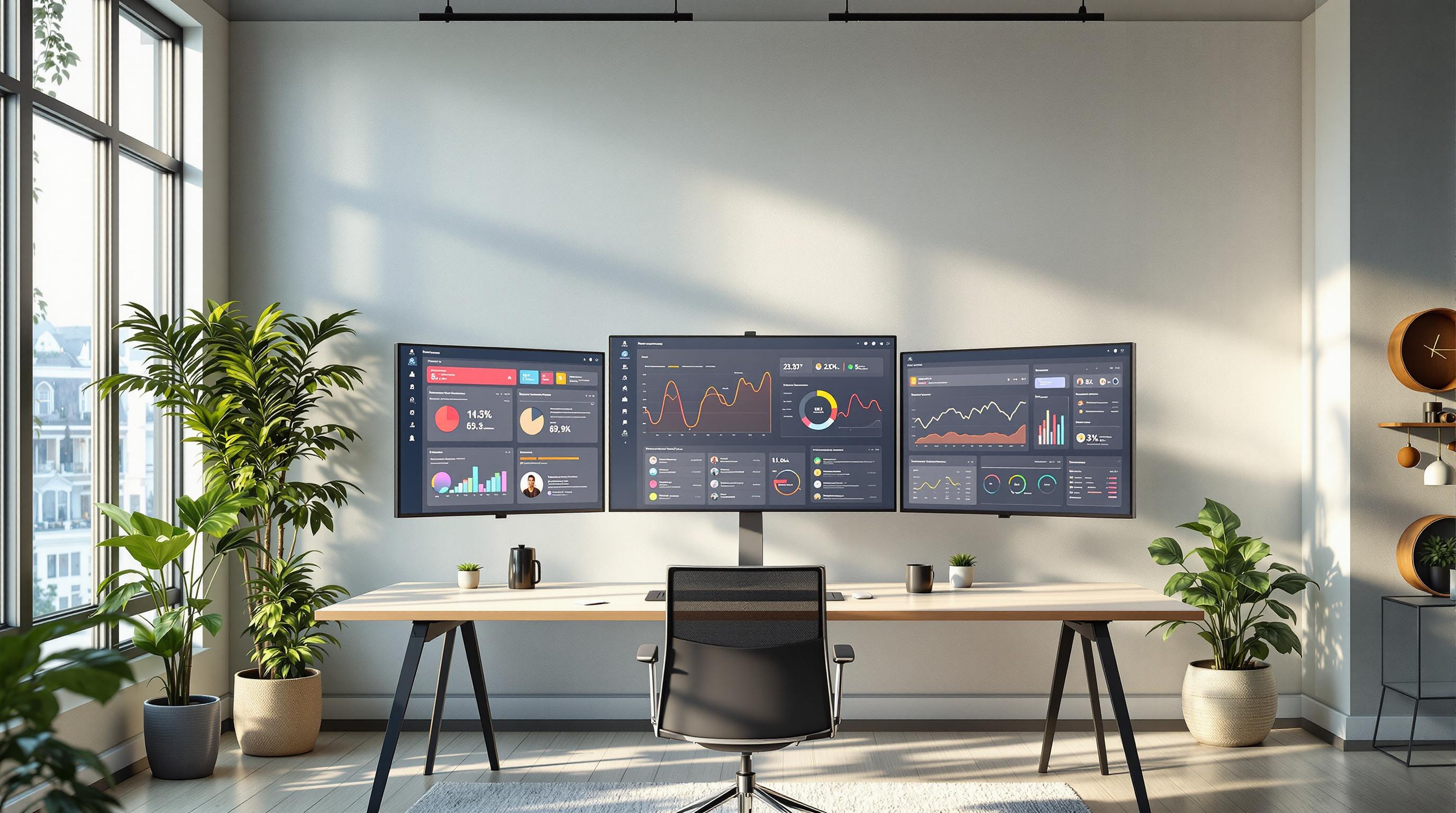Key Takeaways:
- Divide your budget wisely: Spend 40-60% on core platforms, 20-30% on testing, and 10-20% on niche channels.
- Platform costs vary: Google Ads has a high average CPC ($4.22), while Facebook Ads is more affordable (77¢ per click).
- Match goals with platforms:
- Sales conversions: Google Ads ($31.61 CPA)
- Brand awareness: Facebook/Instagram ($18.68 CPA)
- E-commerce: Amazon Ads (varies by category)
- Optimize for ROI: Use tools like AdAlchemy.ai or Optmyzr for automation and real-time budget adjustments.
Quick Comparison:
| Platform | Avg. CPC | Avg. CPA | Best For |
|---|---|---|---|
| Google Ads | $4.22 | $31.61 | High-intent searches, sales |
| Facebook Ads | $0.77 | $18.68 | Brand awareness, engagement |
| Amazon Ads | Varies | Varies | E-commerce, product sales |
Tailor your PPC strategy by platform, focus on data-driven decisions, and use AI tools to maximize your ad spend. The rest of the article dives deeper into platform-specific budgeting tips, advanced strategies, and tools to refine your approach.
The 60/40 Google Ads Budget Allocation Rule
Factors Influencing PPC Budget Allocation
Allocating your PPC budget wisely requires paying attention to several important factors. Let’s break down what you need to consider when distributing your budget across platforms.
Campaign Goals and Objectives
Your campaign’s purpose plays a huge role in deciding how to spend your PPC budget. Different goals demand different investment strategies:
| Campaign Type | Typical Budget Range | Platform Priority |
|---|---|---|
| Brand Awareness | $25,000-30,000 | Facebook/Instagram (Primary), Display Networks |
| Lead Generation | $15,000-25,000 | Google Ads (Primary), LinkedIn |
| Direct Sales | $10,000-15,000 | Google Ads, Amazon Advertising |
"Clear goals are essential to guide budget allocation effectively" [3].
Audience Targeting and Platform Fit
After setting your goals, it’s crucial to understand your audience and their platform preferences. Matching platform strengths with audience demographics helps you get the most out of your budget. For instance, LinkedIn works well for professional audiences, while Instagram is ideal for reaching consumers. Timing also matters - allocate more budget during periods of peak engagement.
"PPC campaigns are key to delivering targeted marketing messages" [4].
Performance Data and Historical Insights
Past performance data is a goldmine for fine-tuning your budget strategy. By combining audience insights with historical trends, you can adjust your spending to maximize ROI. For example, e-commerce businesses often ramp up budgets during holiday seasons to capture increased demand.
"Integrating lead data into your CRM is critical for tracking PPC ROI" [5].
Companies that use historical data to guide their PPC budget decisions have reported up to a 200% boost in ROI [2].
Budgeting Strategies for Specific Platforms
After considering the factors that influence your budget, the next step is to tailor your strategy for each platform to ensure your ad dollars are well spent.
Budgeting for Google Ads
Google Ads dominates the PPC advertising space, holding around 39% of the global digital ad market. Its strength lies in targeting users with high intent - people actively searching for products or services.
Here’s a tried-and-true approach to distributing your Google Ads budget:
| Campaign Type | Budget Allocation | Best Use Case |
|---|---|---|
| Search Ads | 60% | Driving direct sales and leads |
| Display Network | 25% | Building brand awareness and retargeting |
| YouTube Ads | 15% | Engaging users with video and top-of-funnel activities |
"Proper planning, data-driven goals, and continuous optimization prevent overspending and maximize ROI." - Scott Goodale, Author [6]
Budgeting for Facebook and Instagram Ads
Meta's platforms - Facebook and Instagram - are known for their ability to generate engagement and boost brand visibility at a lower cost per click (CPC) compared to Google Ads. With an average CPC of $0.97, they’re an excellent option for businesses working with tighter budgets.
Here’s how you can allocate your budget effectively:
| Ad Objective | Recommended Daily Budget | Expected Results |
|---|---|---|
| Brand Awareness | $20-30 | 2,000-3,000 impressions |
| Lead Generation | $30-50 | 15-25 qualified leads |
| Conversion | $50-100 | 5-10 sales (varies by industry) |
Budgeting for Amazon Advertising
Amazon Ads, particularly for e-commerce brands, require a specialized approach. A typical budget breakdown for Amazon PPC campaigns looks like this:
| Ad Type | Budget % | Primary Purpose |
|---|---|---|
| Sponsored Products | 75% | Driving direct product sales |
| Sponsored Brands | 20% | Increasing brand visibility |
| Sponsored Display | 5% | Retargeting and remarketing |
For new sellers, it’s wise to allocate 30-35% of your revenue to Amazon PPC. As you gain experience and optimize campaigns, this can drop to around 10%. During high-demand periods like Q4, consider boosting your budget by 25-50% to take advantage of increased conversions. Don’t forget to keep a presence on Google Ads, which offers an $8 return for every $1.60 spent.
Key Budget Optimization Tips:
- Adjust spending based on each platform’s performance metrics.
- Leverage automated bidding tools to fine-tune campaigns in real time.
- Regularly review ROI data and reallocate funds to top-performing campaigns.
With these platform-specific strategies in place, you’ll be ready to explore more advanced techniques for managing your PPC budget effectively.
Advanced Techniques for PPC Budget Management
Effectively managing PPC budgets across various platforms requires strategic approaches and the right tools to get the most out of your ad spend. Marketers today are using advanced methods to improve campaign outcomes and maximize returns.
Budget Allocation Across Platforms
Research from Nielsen reveals that ads shown across multiple platforms result in a 250% increase in engagement compared to single-platform campaigns. This underscores the value of spreading your budget wisely across different channels.
| Budget Category | Allocation | Purpose |
|---|---|---|
| Established Channels | 70-90% | Focus on platforms with proven performance |
| Testing & Innovation | 10-30% | Experiment with new platforms and strategies |
After allocating your budget, incorporating AI tools can help fine-tune your spending and boost your return on investment.
Using AI and Automation
AI tools have transformed PPC budget management, enabling lower costs and better results. Here are some standout options:
| Tool | Key Feature | Impact |
|---|---|---|
| AdAlchemy.ai | Smart bids and ad relevance | Enhances campaign performance |
| Optmyzr | Rule-based automation | Handles up to $10K spend across 25 accounts |
| Quartile | AI-driven insights | Tailored for Amazon and Google Ads campaigns |
For example, one agency reported a 42% drop in Google Ads cost per lead after adopting automated budget management tools [1].
Real-Time Budget Adjustments
AI tools don't just help with initial planning - they also make real-time adjustments based on performance metrics. Here are some ways to optimize:
- Track conversion rates and geographic trends to refine targeting.
- Cut spending on low-performing campaigns and redirect funds to better-performing ones.
- Adjust bids according to device performance and time-of-day trends.
- Use automated budget pacing to evenly distribute spending.
"AI technology can significantly enhance your PPC ads by optimizing various aspects. Based on real-time data analysis, it can automate bid management, target audience segmentation, and ad placement." - Sanja Trajcheva, Content Writer at CHEQ [8]
One company saw a 30% improvement in performance within the first month of using optimization notifications, along with a similar boost in leads and impressions [4].
sbb-itb-89b8f36
Tools and Resources for PPC Budgeting
Effectively managing PPC budgets means using tools that help control spending and improve campaign results. To make the most of advanced methods like AI-driven insights and real-time adjustments, marketers need reliable tools to simplify budgeting and enhance performance.
Top PPC Marketing Directory

This platform helps marketers discover tools for automated bidding and campaign monitoring, customized to their needs:
| Category | Available Resources |
|---|---|
| Campaign Management | Budget tracking, automation tools |
| Bid Management | Real-time adjustments, automated bidding |
| Performance Analysis | Analytics tools, reporting solutions |
| Ad Optimization | A/B testing, ad copy tools |
Other Budgeting and Analytics Tools
Here are some popular tools that have become go-to options for PPC budget management:
| Tool | Key Features | Starting Price |
|---|---|---|
| Ruler Analytics | Tracks revenue attribution across campaigns | £199/month |
| AdEspresso | Simplifies automated budget allocation | $49/month |
| Optmyzr | Offers advanced budget pacing | $649/month |
| Acquisio | AI-driven budget optimization | Custom pricing |
"Scalable PPC tools prevent overspending while preserving ad performance and boosting ROI." - Gary, Digital Marketing Head/CEO
Key Tools and Their Functions:
- Ruler Analytics: Captures detailed visitor-level data for accurate revenue attribution across campaigns.
- Acquisio: Leverages AI to adjust budgets across search, social, and display ads based on performance metrics.
- TrueClicks: Provides real-time alerts, automated pacing, and comprehensive cross-platform tracking.
Using the right tools is just the beginning - regularly monitoring and fine-tuning your budget ensures you achieve the best ROI for your campaigns.
Evaluating and Improving Budget Efficiency
Key Metrics and Monitoring Strategies
Keep an eye on these metrics to measure how effectively your budget is being used and to fine-tune your spending:
| Metric | Industry Benchmark |
|---|---|
| ROAS (Return on Ad Spend) | 4:1 (e-commerce) |
| CTR (Click-Through Rate) | 1.7% B2B tech, 5.6% healthcare |
| CPA (Cost Per Acquisition) | Depends on platform and industry |
| Quality Score | Scale of 1-10 |
A higher Quality Score can cut down your cost per click while keeping your ad positions strong. Dive into daily performance data, geographic trends, and device-specific insights to spot inefficiencies and improve campaign outcomes.
Tools like Ruler Analytics or Optmyzr can simplify this process, helping you quickly identify areas that need attention.
"To optimize your PPC budget, detect any leaks or inefficiencies in the funnel." - Borys Vasylchuk, Performance Marketing Expert at Coupler.io
Refining Budget Allocation
Here are some practical ways to fine-tune your PPC budget:
- Adjust bids based on performance patterns, like time of day
- Shift funds toward campaigns delivering the highest ROI
- Experiment with different ad formats to boost ROAS
- Modify spending based on geographic and device-specific data
"The PPC landscape is constantly changing and evolving, and it's vital to keep up!" - Daria Ivanchik, PPC Growth Leader at Aimers
Mastering PPC Budgeting Across Platforms
Managing PPC budgets effectively means adjusting strategies to match each platform's cost structures and audience behavior. Success in cross-platform PPC campaigns hinges on three key elements:
Platform-Specific Insights
Each platform has its strengths - Google Ads is great for high-intent searches, while Facebook Ads works well for building brand awareness. Knowing these differences helps you allocate budgets wisely.
Using Data to Guide Decisions
Analyzing historical performance data is crucial for refining strategies and improving ROI. Regularly reviewing metrics allows marketers to make smarter choices about where to invest resources and how to adjust campaigns [2][5].
Flexible Budget Management
Shifting resources based on real-time data keeps campaigns responsive to changing conditions. This approach ensures you’re consistently maximizing ROI while adapting to market trends [2][5].
To excel in PPC management, consider using tools from the Top PPC Marketing Directory. These tools can help with tasks like campaign management, bid adjustments, and tracking performance, giving you an edge in platform-specific advertising.
PPC budgeting is an ongoing process. As algorithms evolve and markets shift, your strategy should stay adaptable and data-driven, always focused on your goals and audience behavior.
FAQs
Here are answers to some common questions about PPC budgeting to help you fine-tune your approach.
Which platform is most commonly used for PPC advertising?
Google Ads dominates the PPC space, processing over three billion searches daily. While Facebook Ads also has a massive audience with three billion monthly active users, Google Ads is often the go-to choice for advertisers looking to drive sales due to its extensive reach and ability to target high-intent search traffic [6][7].
| Platform | Average CPC | Average CPA | Key Strength |
|---|---|---|---|
| Google Ads | $4.22 | $31.61 | High-intent search traffic |
| Facebook Ads | $0.77 | $18.68 | Advanced demographic targeting |
How should I allocate my PPC budget across platforms?
Your budget allocation should align with your goals. If you're focused on sales conversions, Google Ads is a strong choice for capturing high-intent searches. For brand awareness, Facebook Ads can be more effective thanks to its precise demographic targeting [1][9].
What's the best way to calculate my PPC budget?
A simple formula can help:
Budget = (Revenue Goal ÷ Conversion Rate) × Average Order Value.
This approach ensures your spending is directly tied to your revenue goals [9].
How do platform costs differ between mobile operating systems?
Mobile ad costs vary by platform. iOS campaigns tend to have higher costs but often deliver better long-term ROI. On the other hand, Android campaigns typically have a lower CPC and provide broader reach, making them ideal for certain strategies [8].
What tools can help optimize my PPC budget allocation?
Several tools can streamline your budget management. Resources like the Top PPC Marketing Directory offer solutions for bid optimization, campaign tracking, and overall performance management, helping you make the most of your budget [9].


